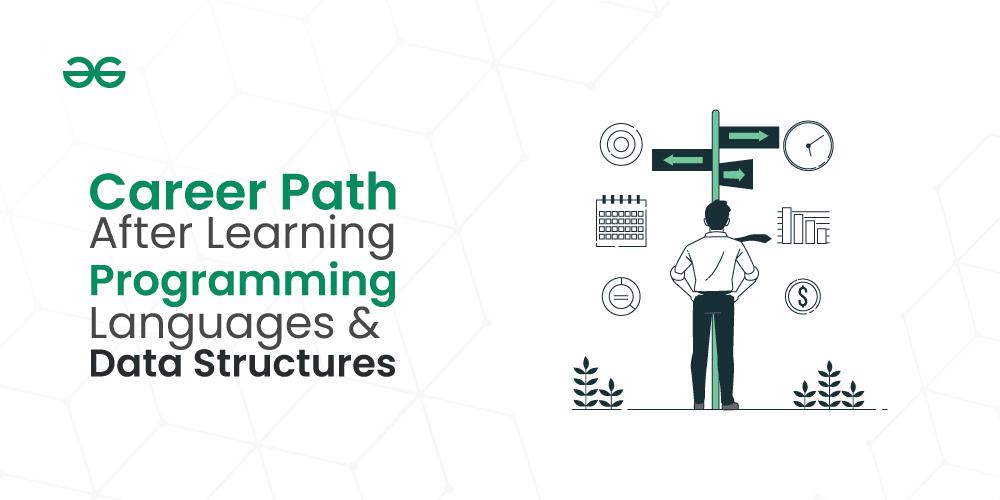Career Path After Learning Basic Programming Languages & Data Structures
Last Updated :
31 Jan, 2024
The career path after acquiring proficiency in basic programming languages and data structures is an important journey in the field of technology. After learning foundational skills, individuals gain entry into a world of opportunities, from excelling in coding competitions and securing internships to shaping efficient software applications and advancing towards specialized domains. This career trajectory involves mastering problem-solving techniques, algorithmic thinking, and the art of writing scalable code. Aspiring professionals discover the gateway to diverse fields, laying the groundwork for continuous learning, potential entrepreneurship, and high-demand roles in an ever-evolving tech-centric world.

Importance of Programming Languages and Data Structures:
Programming languages and Data Structures are fundamental building blocks of software development. They provide the tools and frameworks necessary to create functional and efficient software applications. Understanding and mastering these concepts is essential for anyone seeking a career in the programming industry.
The importance of programming languages and data structures lies in their fundamental role in software development. They enable programmers to:
1. Design and develop software applications:
Programming languages provide the tools to create software applications that solve real-world problems. Programmers use programming languages to define the functionality, logic, and behavior of software applications. Data structures, in turn, ensure that the data used within these applications is organized and maintained efficiently, allowing for optimized data access and retrieval.
2. Problem-Solving and Algorithmic Thinking:
Mastering programming languages and data structures cultivates problem-solving skills and algorithmic thinking. Programmers learn to break down complex problems into smaller, manageable steps, design efficient algorithms, and implement them using appropriate programming constructs.
3. Write efficient and scalable code:
Understanding data structures and algorithms allows programmers to write code that is optimized for performance and scalability. This is crucial for developing high-performance software that can handle large amounts of data and complex tasks. Efficient code ensures that software applications run smoothly, consume fewer resources, and can handle increasing data volumes without compromising performance.
4. Data Organization and Management:
Data structures provide the mechanisms for organizing, storing, and retrieving data efficiently within a computer’s memory. They ensure that data is accessible, searchable, and manageable, enabling efficient data-driven applications.
5. Solve complex computational problems:
Algorithms, which are often expressed in programming languages, are the foundation for solving complex computational problems. Algorithms are step-by-step procedures that define how to solve a specific problem. Data structures provide the underlying framework for implementing these algorithms effectively, ensuring that the algorithm can access and manipulate data efficiently to solve the problem.
6. Build a foundation for further learning:
Programming languages and data structures are the core concepts of computer science. Mastering these basics provides a strong foundation for exploring more advanced topics in software development, such as artificial intelligence, machine learning, and cybersecurity. Understanding programming languages and data structures enables individuals to grasp more complex algorithms, design efficient data models, and develop innovative software solutions in various fields.
7. Career Opportunities and Demand:
The demand for skilled programmers is high and continues to grow as technology becomes increasingly integrated into every aspect of our lives. Learning programming languages and data structures opens doors to a wide range of career opportunities in various fields, with excellent job prospects and earning potential.
Career Opportunities:
Learning Programming Languages and Data Structures opens doors to a wide range of career opportunities.
| Hiring Contests |
Companies conduct contests on coding platforms (e.g., GFG) to assess problem-solving skills. Jobathons by GFG offer job opportunities with top MNCs. |
| Internships |
Apply for internships using problem-solving skills. Understanding basic Data Structures aids in assessments and interviews. |
| Software Development |
Essential for designing efficient software applications across platforms (desktop, mobile, web) by improving application efficiency. |
| Certifications |
Earn certificates on coding platforms to showcase skills. Certificates validate expertise, enhance credibility, and improve marketability. |
| Validation of Skills |
Certificates serve as evidence of expertise, showcasing commitment to professional development. Enhances credibility and marketability. |
| Earning Potential |
Certificates are recognized measures of competence, positively impacting earning potential and professional recognition. |
| Career Advancement |
Boosts chances of promotions and career advancement opportunities. Recognized certifications offer benefits in the competitive job market. |
| Wide Range of Industries |
Programming skills are crucial in various tech companies, from startups to giants like Google, Amazon, and Microsoft. |
| Diverse Career Paths |
Options include Web Development, Software Development, Data Science, Machine Learning, AI, Cybersecurity, Game Development. |
| High Salaries and Job Prospects |
High demand for skilled programmers leads to competitive salaries, job security, and attractive benefits. |
| Opportunities for Entrepreneurship |
Enables creating innovative products, starting businesses, freelancing, and exploring remote work opportunities. |
| Continuous Learning |
Programming requires continuous learning due to evolving technologies, fostering growth and specialization in specific domains. |
Conclusion:
In conclusion, learning programming languages and data structures is a valuable investment in your future. It empowers you to pursue exciting, rewarding, and in-demand careers across various industries, with opportunities for continuous learning, growth, innovation, and entrepreneurship.
Share your thoughts in the comments
Please Login to comment...